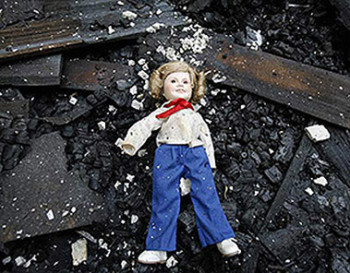
iMediaEthics launched an investigation after bloggers and others questioned the validity of a Reuters photograph that featured an unburned doll lying on top of the charred remains of a California house. Now Reuters is stonewalling efforts to bring in fire engineering experts to analyze high-resolution photographs.
iMediaEthics is also investigating the possibility that a Reuters photojournalist trespassed on private property to obtain photographs of a tragically destroyed home. In the face of misogynist, hate-filled campaign against Rhonda Roland Shearer and her daughter, by a “friend” of the photographer, Shearer continues to ask Reuters to live up to the standards of ethics and integrity professed by its CEO, Tom Glocer.
Story Highlights:
-
- iMediaEthics investigates Reuters’ controversial miracle fire-doll photographs, asks if the doll was fireproof or was placed or fell into the ruins after the fire?
-
- Reuters claims it knows, but will not reveal, where the photos were taken. SJ offers $1,000 reward for information that identifies Rancho Santa Fe (Calif.) house location.
-
- Reuters refuses to answer whether or not its employee trespassed on private property to obtain the photographs illegally.
-
- Reuters refuses to provide fire engineering experts – its own or ours — with the high-resolution fire-doll photos for examination.
-
- Tom Glocer, Reuters CEO, writes to iMediaEthics stating he “launched a full investigation” into misogynist hate campaign against iMediaEthics publisher Rhonda Roland Shearer (and her daughter) condoned by Mario Anzuoni, the Reuters photojournalist who’s credited for the fire-doll photos.
-
- Glocer, addressing the allegations of porn filled attacks against Shearer and her daughter, writes “Under no circumstances will Reuters condone any form of sexual or other discrimination or aggression.” Glocer CCs his top brass, Rosemary Martin, Stephen Dando and David Schlesinger.
-
- North County Times, managing editor, Dan McSwain said he values iMediaEthics’s role: “So you [iME] actually helped us uncover a hole in our education here. We’re in the process of letting everybody know that, ‘hey, here’s the deal…if there’s a landslide, or an earthquake, or if our nuke goes down, stay off of private property.’ ”
- Stinky News Channel parody video debuts on YouTube.com. “We Will Burn Doll: Reuters’ real or placed doll needs test.”




More photos of the doll and the little girl’s bedroom, shot by Reuters’ photojournalist, Mario Anzuoni, in Rancho Santa Fe area , October 23, 2007. Published October 24, 2007.
I tried to imagine what it would feel like to be evacuated from my house and then to open my laptop in a cheap motel or relative’s basement, only to find that images of my little girl’s doll and other personal items, strewn through the ruins of my house, were now for public consumption on Reuters and Yahoo! News galleries.
Thankfully, for me, this was just a thought experiment. Others may not be so lucky. So far, we have been unable to locate them or the house, despite an extensive search. They likely are still unaware that their daughter’s Shirley Temple doll and the interior of her bedroom is being shown globally online, on Reuters, Yahoo and ABC news sites.
The Reuters headline read “A doll lies in destroyed home near Rancho Santa Fe near San Diego” dated 24 Oct 2007.
“A doll lies in the charred rubble of a home in the Rancho Santa Fe area of San Diego, California” and “The charred remains of a girl’s bedroom are seen through a shattered window of a home in the Rancho Santa Fe area of San Diego, California October 23, 2007.” were among the captions under Reuters wildfire photographs published on the Reuters, Yahoo! News and ABC News Web sites.
The photos offer viewers undeniable proof that Reuters photojournalist Mario Anzuoni had entered a private home to snap his photos. This particular homeowner would most likely have been evacuated on the Oct. 22, 2007, and not been allowed to return until Oct. 25.
By Oct. 24, it was too late to protest. Reuters and Yahoo! News had published the photos online.
So how could this family possibly have authorized Reuters entry, let alone the publication of these photographs?
The ethical issues for the media here, as well as laws in all 50 United States, are clear-cut. In practice, though, they can be forgotten during the adrenaline rush of covering disasters like Hurricane Katrina and the California wildfires.
Are Reuters reporters somehow immune to private property restrictions? Are Reuters employees free to enter, without knowledge or consent, and take photos of personal possessions during an emergency, when victims are most vulnerable? No.
At least five photographs taken by Reuters photojournalist Mario Anzuoni were potentially illegally obtained while the Rancho Santa Fe homeowners were evacuated. Homeowners were generally not let back until Oct. 25, 2007.
In the case of the doll photos, there was no clear news imperative to enter this little girl’s bedroom. All of the information gleaned from inside this house – images of destruction, charred rubble, and order amid chaos – could have been captured legally from the street.
Based on this information, we presented some straightforward questions to Reuters:
-
- Did Anzuoni enter “the charred remains of a girl’s bedroom” on October 23rd with the permission of the home’s evacuated owners?
-
- Where was the house located?
- Did Reuters, Anzuoni’s employer, begin on Oct. 24, without the evacuated owner’s authorization, to sell and publish these photos?
Reuters thus far has refused to answer our questions. We wrote Reuters numerous times, beginning with two e-mails on Nov. 2, 2007 and a Nov. 3 query posted on Reuters’ “The Good, the Bad & the Ugly” (GBU) blog.
With no answers, we can only assume that Reuters did not have permission from the owners to enter on Oct. 23, or to sell and publish the photographs by Oct. 24.
Reuters needs to fess up and make transparent any ignorance or violations of state laws regarding Anzuoni’s apparent private property trespass. Reuters also needs to reassure the public that such violations of privacy will not happened again, and such conduct by employees, according to policy, will not be tolerated by Reuters.
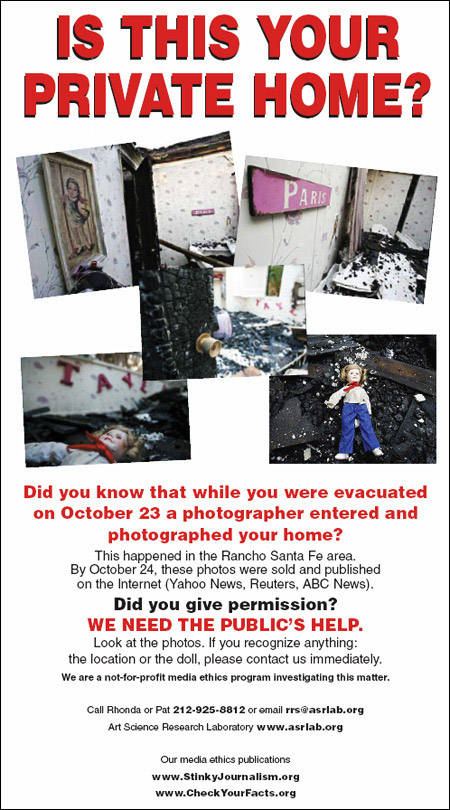
Art Science Research Laboratory’s full page display advertisement ran in the North County Times, a local daily newspaper, that serves the Rancho Santa Fe area of California.
In an attempt to notify the family, and learn where and how the photos were taken, we have posted full page color ads in a local newspaper, the North County Times, which is the publication nearest to the alleged location of the fire-doll house. A bigger regional newspaper, The San Diego Union Tribune, is our next planned ad venue.
Our display ad actually spurred a new policy at the North County Times; journalists are now told to keep out of private homes during an emergency if they do not have permission to enter and take photographs from the property owners.
Dan McSwain, Managing Editor, North County Times, told me, by phone :
“ It turned out that our photographers are fully aware of the guidelines that are already pretty much industry standard, which is you don’t go onto private property, even if the cops go on there, and even if it’s in a disaster area – unless you’ve got the owner’s permission.
It turns out that we had not spread the word to the reporters, who in the new era are walking around with cameras and video cameras. So, you actually helped us uncover a hole in our education here. We’re in the process of letting everybody know that, hey, here’s the deal: You’ve got to please grab fireproof gear; please have hard-toed shoes. We’ve got some other equipment we ordered after the last fire, but just speaking generally if there’s a landslide, or an earthquake, or if our nuke goes down, stay off of private property.”
As iMediaEthics is part of a journalism ethics program, we hope to use this case to promote higher consciousness among media outlets, to encourage them to respect the private property rights of citizens during an emergency.
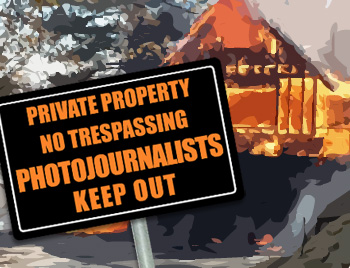
Are no trespassing signs needed to keep out journalists? Collage by Soojin Kim
To get more clarity on industry standards, we referred to The National Press Photojournalists Association (NPPA) about the ethical and legal considerations that should guide photojournalists in such events.
The NPPA’s “National Media Guide for Emergency & Disaster Incidents” is unambiguous on its view of the laws governing restrictions to private property:
| The National Press Photojournalists Association: National Media Guide For Emergency & Disaster Incidents(2nd Edition) A Special ReportPrivate Property Considerations (emphasis original)”Journalists do not have a general right of access to private property. Consent must be obtained from someone in authority to grant it. Consent to enter private property is between media and the person having control of the property – not the public safety agency. Invitation to enter private property location by public safety representatives does not constitute ‘lawful’ permission. Reporters (including photojournalists) should not enter private property with emergency responders. If private parties give the media access to private property, it MUST be clear that the emergency responders are not requesting the media’s presence. Consent is between the media and individual concerned.” When newsworthy events occur on private property, special problems for news photojournalists are sure to follow. Every state has a law that makes it illegal for a person to enter private property without obtaining permission from the property owner; a legal concept commonly called trespassing.” |
On a fateful, smoky day in October a pristine doll is photographed in a little girl’s room.
First, we should acknowledge that Anzuoni was making the rounds in Rancho Santa Fe, Calif., wearing fire gear. (See this self-portrait.) The media trend of journalists wearing the identical fire equipment traditionally worn by rescue workers, may need to be reexamined in light of the fire doll photos. Whether or not by intent, official looking uniforms provide journalists both fire protection and opportunities for disguise. Could Mr. Anzuoni have the same access to this private property if he had been wearing civilian clothes?
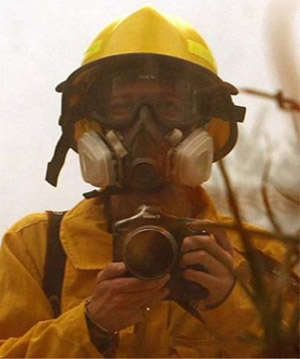
Anzuoni, Reuters’ photojournalist, is shown wearing fire gear in his self portrait, taken October 23, 2007, Rancho Santa Fe area of California
Anzuoni writes in his Reuters blog about Oct. 23: “There is smoke pretty much everywhere; up in the hills, down the creeks, and in the distance. I am looking for live flames, threatened properties, or fire-fighters battling the fire, in an area that has, with the exception of a few news crews, been completely evacuated.”
We do not know yet where the fire-doll house is located. The caption says it was taken in “the Santa Fe area,” but from the five fire-doll photos, we can also see that Anzuoni was definitely working on private property and in the house.
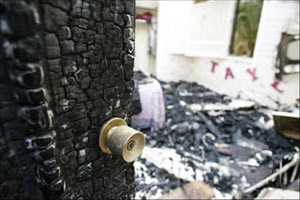
The interior of the little girl’s bedroom. The doll is in the middle of the room amid cinders and ashes.
The transgression here is clear. People feel vulnerable during an evacuation. Unless necessary, they generally don’t even like rescue workers traipsing around in their personal things. Fears abound. The San Diego Union Tribune, Chet Barfield’s report was headlined “Criminals use fires to their advantage; Looting a major concern for those who evacuated.” He wrote, “Police and residents throughout the region are reporting a smattering of cases that, while not widespread, evoke head-shaking disgust.” One Union-Tribune reporter, Blanca Gonzalez’s family, Barfield states “was evacuated earlier this week” only to return late Tuesday “to find their home burglarized.” He quotes one resident who refused to evacuate in order to guard their home. “ ‘Losing your house to a fire is one thing,’ [Caroline] Ramsden said. ‘Losing it to looting is another.’ “
If county or city inspectors are not allowed to enter private homes without the owner’s permission, and often must look into windows to do their inspections, should journalists be allowed carte blanche to shoot from inside?
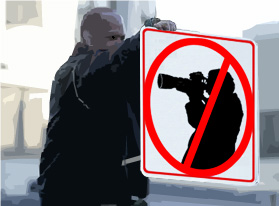
A collage by Soojin Kim proposes a new type of emergency sign to keep out photojournalists
What iMediaEthics is going to do about it
Reuters refuses to tell us or the public if its employee, Mario Anzuoni, had authorization from the owners to enter, photograph and publish photographs of the evacuated home. So we have begun our own investigation of the area in order to find the owners ourselves.
If the house exists, we should find it. After all, there were only so many houses burned near Rancho Santa Fe. However, our preliminary findings caution us that the house may not be where it is purported to exist.
It’s just a matter of checking each one. Only a limited number of houses in that area were not burned to the ground. Inspectors in the city and county have maps of burned areas, lists of damaged homes by address and photos of each house.
Anzuoni’s photographs “speak” to us, even if Reuters and Anzuoni won’t. Clues are revealed. The fire-doll house had standing rooms and walls. The debris scattered around the doll reveals that the house’s roofing material was made of cedar shingles. Few houses in the area have cedar shingles; fire regulations have mandated that new houses be built with tile roofs.
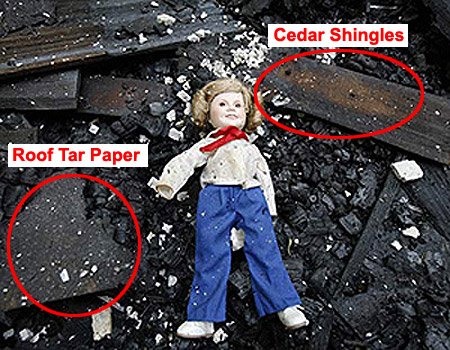
The debris scattered around the doll reveals that the house’s roofing material was made of cedar shingles. Few houses in the area have cedar shingles; fire regulations have mandated that new houses be built with tile roofs.
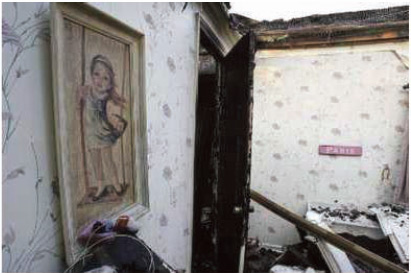
No smoke or smoldering debris evidenced in the little girl’s room indicates the fire was extinguished for some time, according to experts. Details in Part II of this Special Report.
The photos also tell us something about the time of day that the photos were taken. The air in the photos is crystal clear. Importantly, the photos show no indication of the smoke-choked sky with raining embers and ash that Anzuoni describes in his Reuters blog entry. Instead of the “live flames, threatened properties, or fire-fighters battling the fire” Anzuoni said he was looking for, the ruins in these photos, and the pristine doll, speak only of a fire extinguished long before.
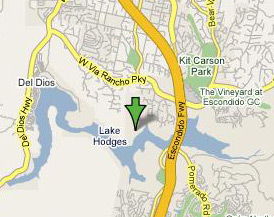
This map shows the relationship of Del Dios Hwy to the Lake Hodges area where Anzuoni was taking photographs.

Anzuoni was wrong when he identified the Del Dios Hwy as Route 76. See map.
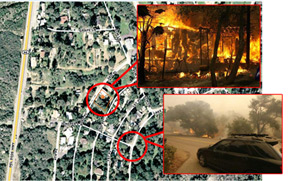
Two photos Anzuoni published in his blog, of a burning house and the street corner where he parked his car, provided enough clues such that we were able to find both locations.
We are also looking to see how many households in the area have children. All this will be revealed in due time, through boots-on-the-ground sleuth work, detailed in our forthcoming second report, as the facts roll in.
North County Times reporter Phillip K. Ireland told me, for example, he saw Anzuoni in this smoke-choked area between 9 a.m. and 11 a.m.; however, there was no smoldering debris in the fire-doll photos. The air was clear, not hazy as Anzuoni reported. So the house we are seeking was presumably not “one of 10 houses” Anzuoni mentioned in the Lake Hodges, Calif. Area, where the fire raged and he took photographs.
Anzuoni’s story states the wrong highway number
“I am driving toward Rancho Santa Fe, on highway 76, known as Del Dios highway (the highway of God),” Anzuoni wrote on his blog. The problem is that Del Dios Highway is not Highway 76. The distance from Del Dios Highway to Highway 76, is about 15.5 miles.
However, his blog still provides some useful leads as to where the fire-doll house is or isn’t and it verifies what Anzuoni did on Oct. 23, 2007.
For example, the photos of the burning house and the street corner where he parked his car provided enough clues such that we were able to find both locations. See our photos with landmarks, which are identical to the unmistakable matching features in Anzuoni’s two photos:
The street sign in Anzuoni’s photos just peaks into the frame, in the upper left, but is clearly visible in our photographs as Lake Drive and Juniper.
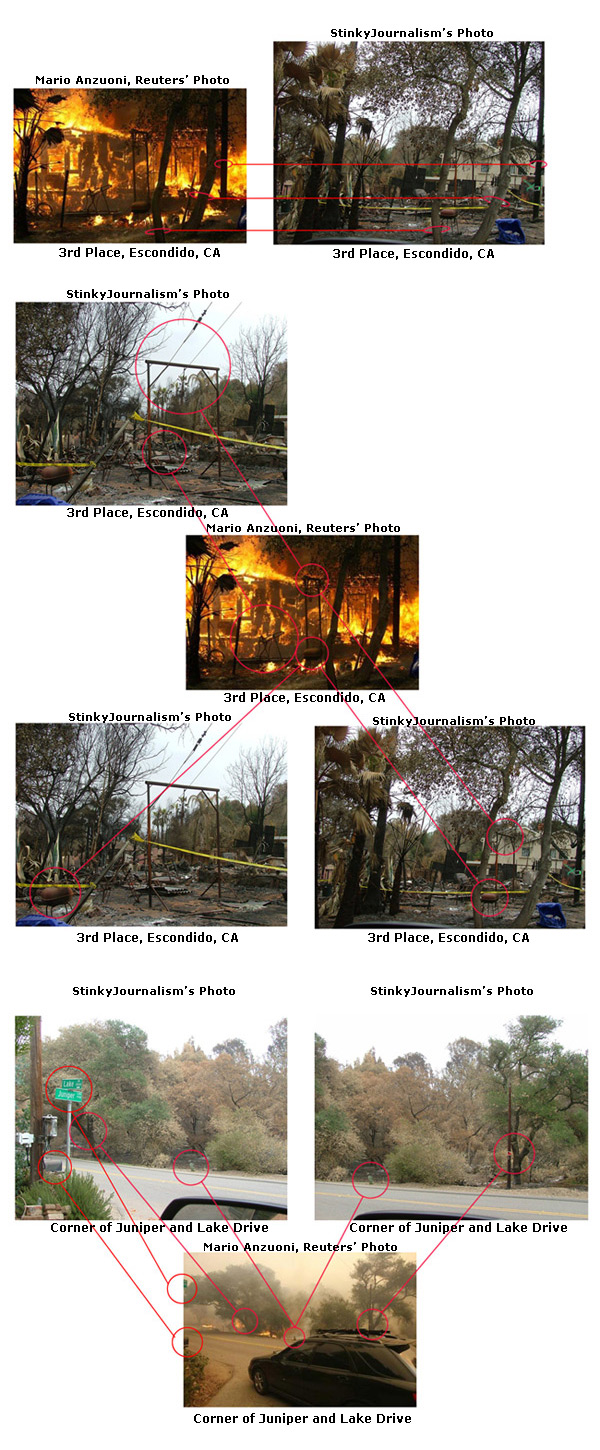
The photos of the burning house and the street corner where he parked his car provided enough clues such that we were able to find both locations. See our photos with landmarks, which are identical to the unmistakable matching features in Anzuoni’s two photos.
Is it possible that the Anzuoni fire-doll photos were not taken in the Del Dios shoot he wrote about? He states that his “next stop” after Del Dios was “the evacuation center at Del Mar Fairgrounds.” We must then assume that he took the fire-doll photos before Del Dios. But that seems unlikely since his story starts on Del Dios Highway. The other possibility is that he took the photos after Del Dios and the Del Mar Fairgrounds.
Do Reuters editors really think they can make the public believe that a doll made of fabric and acrylic survived “serious fire damage?”
Bloggers cried foul over the fireproof doll photos almost immediately after they were published on Oct. 24, 2007. Reuters answer wasn’t “We don’t know how the doll got there in the ashes. But isn’t it an interesting photo?” With that response, the controversy , like the California fires themselves, would have been extinguished.
But Reuters wanted a miracle.
DOLL WARS: The Reuters fire doll on the left clearly meets our expectations regarding what a doll should look like after a devastating fire reduces everything to ashes, unlike the miracle fire doll on the right. It is interesting to note, that these photos were taken by two different Reuters photographers during the same wildfire in the “Rancho Santa Fe”<
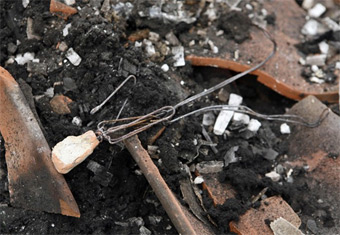
Reuters original caption: “ 1 month ago: The wire frame and head are all that remains of a doll in the aftermath of wildfires in Rancho Santa Fe, California October 27, 2007.” REUTERS/John Gress (UNITED STATES)
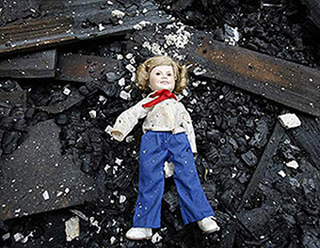
Reuters original caption: “A doll lies in the charred rubble of a home in the Rancho Santa Fe area of San Diego, California October 23, 2007.” REUTERS/Mario Anzuoni (UNITED STATES)
Despite publishing a doll photo from the same California firestorms that meets our expectations of what a real doll would look like after a decimating blaze (see left image above, by John Gress), Reuters declared Anzuoni’s doll in the rubble photo “authentic.” Reuters insisted that the photo depicted an original and authentic fire scene, untouched by human hands as documented by its photojournalist. Reuters editors wrote : “The photo is fine. We have examined the whole sequence of pictures that included this one, and there are a number of things in the house – a doorknob here, a picture frame there, etc. – that appear clean despite the serious fire damage around them: GBU Editor.”
No one placed the doll after the fire was out, Reuters decided. If a doorknob and frames survived without damage around them, they reckoned then, that so could – and more importantly, so did – the doll also miraculously survive.
How did Reuters editors arrive at this conclusion? Was it through outside consultants, experts in judging the authenticity of fire scenes, bench scientists capable of testing fireproof materials, fire science engineers proficient in examining staged fires? In their investigation of the photo’s authenticity and quest to keep the public’s trust, did they show the photographs to the Rancho Santa Fe Fire Protection District Fire Chief Nicholas G. Pavone, or Fire Marshal, Cliff Hunter and ask for their informed opinions or facts ?
No. But iMediaEthics did. We will report all our many experts’ finding in Part II of our special report. All of our fire science experts, including local chiefs and marshals familiar with the area fires and housing, concluded the doll had to been placed into the scene after the fire was extinguished.
The blog response
Writing on Reuters’ editorial blog “The Good, the Bad & the Ugly” (GBU), a reader named Jer stated: “Your picture reminds me of the photos you published during the Israel – Lebanon war. Please engage your brains BEFORE publishing. How did this nice clean doll (with clean white pants[sic] ) survive a fire that totally gutted the house that it is pictured in? Come on you all. WAKE UP.”
In a similar vein, AnAmericanfirst wrote on Oct. 25, 2007: “When I saw this, something just struck me as odd … look closely at the doll. It is pristine. The hair is not singed together, there is not a smudge on the face or clothing. There is no indication that it was ever in the proximity of smoke. The ribbon is bright red and the shoes snow white … I’m sorry, but I just don’t feel like I can trust anything that comes from Reuters … Faked Reuters Photos: Not just for war anymore!”
The doll caper can be better understood in the context of the “fauxtography” scandal that rocked Reuters last year. The blogosphere provided ample evidence that images produced by Reuters stringer Adnan Hajj during the Lebanon-Israel conflict had been altered. The debacle eventually resulted in the removal of all of Hajj’s work, 920 photographs, from the Reuters archives. In addition to direct action against the photojournalist, Tom Glocer, Reuters CEO publicly fell on the sword while crediting blogger Charles Johnson, littlegreenfootballs, with the discovery of fraud.

Image and Caption from littlegreenfootballs.com “Animated GIF showing the section that is very obviously duplicated Smoke billows from burning buildings destroyed during an overnight Israeli air raid on Beirut’s suburbs August 5, 2006. Many buildings were flattened during the attack. REUTERS/Adnan Hajj”
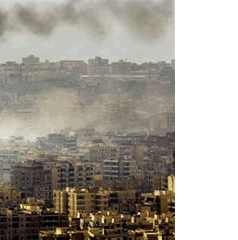
Image and Caption from littlegreenfootballs.com. “The overlay showing the common area of two photos, clearly cropped from a larger panorama shot.”
The 2006 controversy included questioning and evidence, which eventually indicated that staging of photographs by combatants for propagation purposes had occurred. ZombieTime has a section, particularly relevant to the fire-doll photograph titled “Photographers themselves staging scenes or moving objects, and presenting photos of the set-ups as if they were naturally occurring” ZombieTime writes, “Dozens of blogs have pointed out similar questions about other artificial-seeming scenes that smacked of the photographers’ handiwork. The most comical of these is ‘The Passion of the Toys’ at Slublog.”
ZombieTime cautioned , “But this is not a definitely conclusive example of fraud – it’s almost impossible to prove that a photographer moved an object to his benefit. Instead, the images just feel faked.”Unlike the explosion images, in the case of the fire doll photos, we do have the capability to determine whether or not the Shirley Temple collectable survived the surrounding fire. We don’t have a case of war combatants moving objects for propaganda purposes.
The issue isn’t necessarily even “Who moved the doll,” but a question: Was the doll, original to the fire scene, able to survive (by some miracle) nearly unblemished, or was it placed? Or did it, some way yet to be determined, fall on top of the roof materials after the fire was out?
Reuter’s experience with the 2006 photo scandal did not seem to improve its handling of the fire-doll controversy
The Reuters “editorial” inquiry that followed the fire-doll controversy was hardly an improvement indicating lessons learned from the August 2006 scandal. There was no evidence of a “Let’s get to the bottom of this” approach in their October 29th post.
Reuters in a second blog post reasserted that its editors believed the doll survived without a blemish and posted photos that showed other items–metal and wood objects– were also unscathed in the same fire-ravaged room. When pressed, they dug themselves in even further, when they wrote:
“Recently, this blog published some reader criticism questioning the validity of a Reuters photograph from the California fires. Here are the posting and subsequent reader comments. The issue continues to draw attention and debate, and today we are posting several other shots from the same sequence, below.“It is important to understand that accuracy and impartiality are central to our reporting, and to everything Reuters represents. We distribute approximately 1,500 pictures per day, and these pass through rigorous editorial evaluation and selection to make it onto our wire. We stand behind the authenticity and accuracy of both the original photo, and the additional images supplied.”
An appeal to its own authority – with no explanation of how the doll could have survived the fires, or a list of methods used to make such a determination – does nothing to satisfy the challenge afoot to the credibility of this photograph.Editors perhaps thought, even hoped, that an unblemished doorknob and picture frames surviving the intense fire would help their case.
However, to stop there, and to not verify that assumption with experts is an affront to the ethical position that requires journalists to verify information.More damning is that our experts have identified the debris surrounding the doll as roof materials – cedar shingles and tar paper.
So, after the burning roof collapsed into the girl’s room we are supposed to believe that the doll somehow ended up not under, but on top of the still burning roof debris?Upon reading these unscientific conclusions and wonky circular reasoning, Art Science Research Laboratory (ASRL), publisher of iMediaEthics, jumped into the mix on Oct. 30, 2007.
|
Reuters’ published “miracle toy in the ruins” photos before 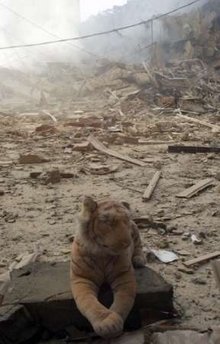 Figure 23. Sharif Karim, Reuters
|
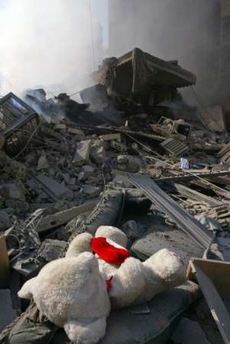 Figure 24. Sharif Karim, Reuters
|
 Figure 25. Sharif Karim, Reuters
|
| ZombieTime writes “All of these pictures were taken by Reuters photographers in Lebanon … While it may be possible that these photographers all just happened to stumble on toys and stuffed animals perfectly positioned for maximum emotive response, the cumulative effect of all the pictures together (along with others visible on Slublog) suggests that some if not all of the photographers moved the toys to be better positioned for a good photo. Several readers have also written in to point out how new, clean and undamaged the toys look – unlikely, if they had all just been in an explosion.” |
|
Figure 26. YouTube Video by Dale Fitzgerald, titled ,
“We Will Burn Doll: Reuters’ real or placed doll needs test” Bloggers have asked if the miracle fire doll was staged during the Rancho Santa Fe CA wildfires by a Reuters photographer? How could the doll survive with no smoke or burn damage? If Reuters won’t fork over high rez pictures for our experts to examine, we will be forced to burn this Shirley Temple doll to test if it has special fire retardant properties |
|
We hope to find the location of the Rancho Santa Fe house. We ask anyone with information on this matter – neighbors, friends or the family itself – to contact us. Call Rhonda or Pat at (212) 925-8812 or |
|
Reuters, at first, published weirdly cropped second version of the doll photo 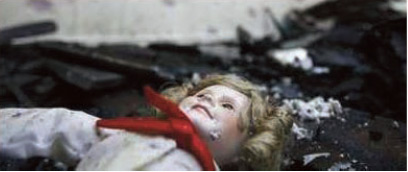 Cropped: It was not until seeing the uncropped version of the second doll photo that one could begin to see the background in relationship to the location of the doll.  Uncropped: The letters on the wall, when seen in the context of all 5 photos of the little girl’s room, begin to offer the viewer a grid in which one can begin to locate the doll, as well as help determine if the doll has been moved in- between shots.
|
We asked Reuters editors, in e-mails and in the GBU comments section, to be transparent and share with the public the rest of the photos it evoked as defense of its photojournalist. (To Reuters editors credit three additional photos were posted on October 31. Two were new, showing the door and two pictures on walls. The third resulted from my request for the un-cropped version of a second view of the same doll photo, that had been published).
iMediaEthics’s approach was to take the debate out of the realm of opinions and encourage Reuters to go to scientific experts in fire engineering. In light of the Lebanon photo debacle, you’d think the news agency might entertain a dialogue and allow experts in fires to take a look. Indeed, this could go a long way towards reestablishing the public’s trust.
Instead, Reuters pronounced the “photos are fine” and then circled the wagons.
Despite offers from preeminent engineers at prestigious universities to examine the high-resolution versions of photos, Reuters stonewalled, refusing to provide them to our – or their own – fire engineering experts.
Part II forthcoming …
The results of our consultations with fire engineering experts and Rancho Santa Fe fire and city officials will be forthcoming in Part II of our special report.
GBU comments sections, following Reuters’ two blog entries on the fire doll, document the evolution of the porn-filled hate campaign, that targeted my daughter and me. Waged in the name of Anzuoni, allegedly, by his “friend” Chris Weeks, links to these XXX attacks remained on the Reuters GBU blog pages, up until several days ago, despite our complaints . Shockingly, despite the Reuters CEO’s personal promise to remove all these offensive links, others continue to remain on Anzuoni’s Reuters blog page.
For those readers who don’t want to wait until Part II, I post here the letter and email exchanges with Tom Glocer, Reuters CEO, and David Schlesinger, Reuters Editor-in-Chief, where I detail evidence of their employee’s involvement by, commission or omission, to humiliate and silence me, a professional investigating Anzuoni’s work. Upon becoming aware of the situation, Glocer’s initial response was swift and appropriate:
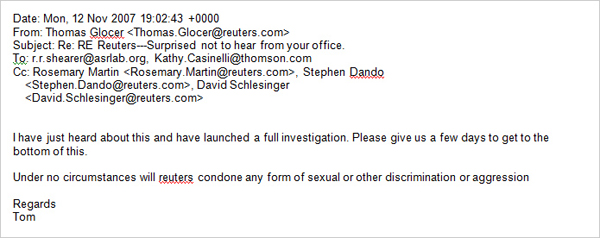 |
Here are the email and letter exchanges that document the sexist and porn filled attacks. Our other complaints are found in the Reuters GBU blog comments. Warning: XXX content. Not for people under 18 years old.
Also, see the two web providers who hosted the smut filled attacks that were linked from Reuters. Despite our numerous requests to remove offensive materials –that are clearly against their posted policies– DeviantArt.com and Uber.com have still not removed all of the slime. Only if you are over 18 years old, see examples of the nasty posts that still remain on DeviantArt and Uber web sites.
We still urge Reuters to do the right thing:
-
- Provide experts – theirs or ours — with the high-resolution fire-doll photos. The question is: Did the doll survive the raging fires or was it placed, or fell into the scene after the fire was extinguished?
-
- Tell us the location of the house so it can be verified in the Rancho Santa Fe area as claimed. There is doubt from our experts (and we are getting to the end of our list) – no house.
-
- Let the public know whether or not their photojournalist illegally entered the house on Oct. 23, and declare if they had the family’s authorization on Oct. 24 to publish the photos. If they didn’t have permission, fess up and reassure the public this won’t happen again.
- Fully investigate the actions and inactions of your editors and photographers, and their involvement in the sexual harassment campaign against me (and my daughter) during my investigation into Reuters photographs.
Conclusion
Our investigation continues. We are now offering a reward of $1,000 for information leading to the identification of the miracle fireproof-doll’s house. Call (212) 925-8812 or email info@asrlab.org.
iMediaEthics may be small and Reuters mighty; however, no one, not even a multibillion dollar behemoth like Reuters, owns the truth.
The truth belongs to the public.







Please let Reuters know what you think about the miracle doll photos or the now acknowledged illegal entrance of a private home in order to obtain, sell and publish photos. Contact them here
I received this email 12/14/07 from one of our readers, Don Bledsoe:
Dear Ms. Shearer,
Thank you for the work you do at ASRL and via Stinky Journalism.
I spent several hours reading your nightmare of an encounter with Reuters and their GBU blog, and the disgusting photo thugs they used in an attempt to smear and discredit you and your daughter, not to mention the death threat. I have read of some ugly attacks on a person on the web but never anything so vile as what you were exposed to via proxy, and with what one could consider the full knowledge of a major corporation such as Reuters for simply questioning a photograph.
I have long not trusted Reuters for their seeming bias and misleading story bylines. The Lebanon war further cemented that distrust, but I thought they would learn a lesson from that debacle. Perhaps not, based on what you’re uncovering about the fireproof doll.
This is just a simple thank you from an average American citizen for the good work you are doing. Please keep it up because you are making a difference for the rest of us.
God bless you and your family and I hope you all have a very Merry Christmas.
Don Bledsoe
Boise, Idaho
I love that there’s no evidence, whatsoever, of actual wrongdoing on the part of Reuters. All you’ve managed to do is say, repeatedly, that the photo is improbable and to baselessly accuse a Reuters photog of illegally entering private property.
This same report would never appear in an actual media source, because it doesn’t meet the factual standards actual journalists live up to. Like most other bloggers and tabloid papers, you throw shots without proof. Prove something and then I’ll care.
Maybe you missed the ethical timer on the home page citing Reuters’ admission that their photographer entered the house despite the fact the renter told him to keep out. It is an acknowleged fact –thanks to Stinky Journalism not MsM–that Mario Anzuoni wrongly entered this private home. Stinky Journalism has brought to the fore that it is illegal for news media to enter private property without permission of the owner or renter. According to victims of disasters, they often feel victimized twice– first by the disaster, then next by the news media. For example, the owner and renters of the "fire doll" house were furious at the violation of their privacy and the trespass. Do you want a photogrpher you don’t know in your house while you are evacuated taking pictures of your little girls room, selling and publishing them on the web without your permission? I frankly doubt that would be okay with you. This problem does not yet address the staging of the photo or the porn filled harassment (incluidng death threats) of me and my daughter by "friends" of the Reuters photographer.
We are careful and complete. Therefore this is the reason why we wanted to finish our investigation and our negotiations with Reuters (regarding what admissions they will make) before publishing Part II. Go to the annoucement on the home page and the ethical count down page.
"NEWS FLASH 01/08/08: Reuters’ Editor-in-Chief now admits their photojournalist Mario Anzuoni entered house during recent California wildfires evacuation without permission and they were wrong to do so. More info soon. Public announcement forthcoming . Time elapsed since SJ first asked Reuters…"
It makes you wonder what other stories, photos, etc. are manipulated in more subtle ways than this farce of a news story.
Ahh! Where’s part two? Was the family found? Did experts recreate the doll miracle?